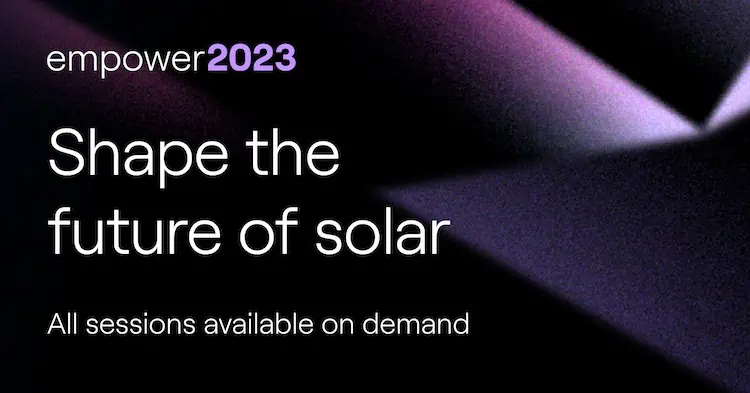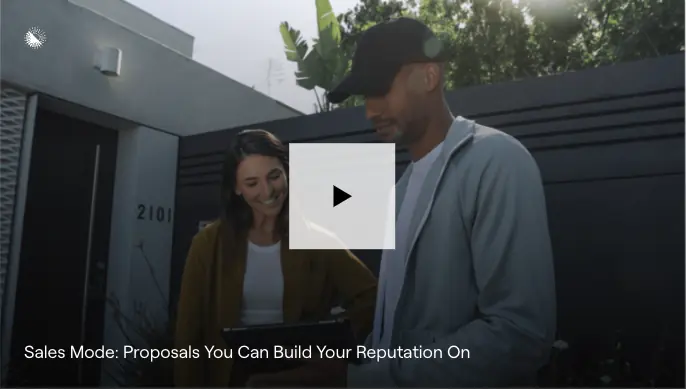Solar represents a significant investment for most homeowners. And the high interest rates we’re seeing, and are likely to continue to see in the near future, can create a potential roadblock, making some potential customers think a PV system may be financially out of reach.
If interest rate concerns have been popping up in your lead funnel lately, you’re not alone. But what can you do to calm those concerns and get the sale back on track?
To help us all sell more solar in times of high financing rates, we turned to the solar pros in our Solar Sales Throwdown at Empower 2023. As with our first blog in this series — “Solar just doesn’t work for us” — we asked our sales experts for their best strategies for overcoming this common, and difficult objection.

To reintroduce our solar pros:
- Kenny Parry, Founder and CEO of Parry Capital
- Jader Leao, General Manager of Vivint Solar
- “Solar” Joe Mousakheel, Owner of The Solar Academy
- Ashleigh Tatarcyk, Owner of Urban Sol Energy
Without further ado, let’s jump in and see how these pros deal with this very common objection.
“Financing rates are too high right now.”
Step 1: Zoom out
When a prospect says that financing rates are too high, it’s very likely that they’re not just talking about solar energy. They’ve probably had first-hand experience with spiking interest rates in other areas, whether for auto loans and credit cards, or even home mortgage financing rates — which are at their highest in decades.
There’s simply no denying the financial pressures many people feel today, so if your lead wants to talk about financing rates, then talk about financing rates. Ask them what rates they’re referring to specifically and how they believe things may change in the future.
By opening the conversation to life’s other expenses beyond energy alone, you can build a rapport that will move prospects to the next step in your lead funnel. At the very worst, putting solar financing rates in perspective can spark your potential customers to pursue a full assessment later — when interest rates go down.
Step 2: Relate personal experiences
Nearly every panelist also expressed that they would relate personal experiences about how high interest rates have affected them. A little bit of empathy can go a long way, so a personal anecdote can help skeptical leads confirm that you do indeed understand the impact of high interest rates, yet still believe solar can save them money.
Ashleigh Tatarcyk, Owner of Urban Sol Energy, would say something like: “I’ve been seeing interest rates impacting everyone across the board. It actually has impacted me. I just bought a new Subaru and my rates were pretty high, but I felt like the need for a new car outweighed the need to keep paying for my old car… It made more sense for me to switch.”
In this example, Tatarcyk argues that the benefits of purchasing a new car will be a better long-term solution when weighed against the costs of repairing an old vehicle. This pretty keen metaphor for purchasing solar to replace utility electricity spending brings us conveniently to our next step…
Step 3: Compare solar to electricity prices
Even with high interest rates, solar is likely still a better financial option for most homeowners than the alternative: exclusively buying utility electricity. Considering the long history of utility rate increases and recently surging electricity prices in the United States, it’s important to emphasize that alternatives to solar are not immune to high or unpredictable costs.
As Joe Mousakheel, Owner of The Solar Academy, put it: “It’s either go solar or stay with the utility…. Utility rates are going higher and higher and higher every year… Do you think they will ever go down?”
When drawing comparisons to utility prices, a fixed-interest-rate loan can also present a huge advantage for solar. While your leads may have no control over utility price changes or costs, a fixed-rate loan can help map out predictable energy expenses and even potentially reduce total investment costs by allowing them to schedule payments early.
It’s also important to emphasize the advantages of solar ownership in that when you pay a solar loan, you own both your system and the energy that it produces. Whereas when you pay a utility bill, that’s money you will never see again.
When a prospect raises financing rate concerns to Kenny Parry with Virtual Solar Pros, he explains: “When paying monthly bills to XYZ utility, nothing is going towards principal, you really don’t own it.”
He then presents the homeowner with a choice: “Think of yourself ten years from now. If you look back to today, what should you have done?”
“Should you spend all that money on utility bills, throwing it out the window and have nothing — except your highest bill ever after ten years. Or would you have this money paying off your system all this time. You have a choice what you do with your money: You can keep throwing it away or start paying yourself.”
Step 4: Do the math
Finally, after putting things in perspective, actually sitting down and doing the math may be the most effective way to demonstrate the potential savings solar can deliver. While it certainly helps to have accurate, easy to use solar sales software ready at your fingertips, doing some simple math can also help quickly illustrate how high financing rates won’t necessarily prevent solar savings.
For example, let’s say that you estimate your lead’s system will cost $25,000, including the financial incentives for installing solar and the total interest to be paid on the loan. If you can demonstrate that the system will eliminate at least $25,000 in utility energy spending over its lifetime, you can then argue that the system will pay for itself, despite high interest rates.
Even if you are able to generate an accurate forecast of potential solar savings, your prospect may not trust your math straight away. If a person is concerned about financing rates, always remember that going solar is a big decision, and they are just being cautious.
The tools you need
Listen, financing is complex. The easier you can make it, the more options you can provide the homeowner, the more likely they are to say, “Yes”. In the newly reimagined Sales Mode, presenting homeowners with financing options that work for them, and helping them understand the costs and savings of going solar, has never been easier.

In closing…
Selling solar in times of high interest rates is not impossible, you just need to put things in perspective and demonstrate how indecision now could prevent financial savings later. Even with a higher-interest loan, homeowners can still save a significant amount of money on energy expenses, and your job is to demonstrate that as clearly as possible.
This is the second of our four-part Sales Objections Throwdown series. Check back each week for another objection, and how to turn it into an opportunity.
Here are the rest of the objections (we’ll link them here as they’re posted):
- “Solar just doesn’t work for us”
- “Financing rates are too high” — this blog
- “I’ve heard that solar won’t save me money in California with NEM 3”
- “We need another quote”
- Frequently heard solar objections, solved!
Want to learn more about the updates to Sales Mode? Check out our Sales Mode webinar on demand!
Have more questions? Schedule a quick chat with one of our experts.

Featured image by Gabriel Mihalcea.


